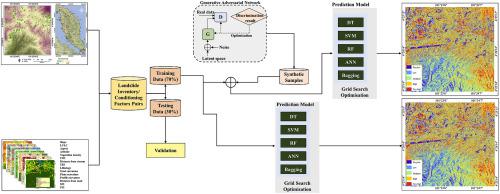Geoscience Frontiers ( IF 8.5 ) Pub Date : 2020-09-15 , DOI: 10.1016/j.gsf.2020.09.002 Husam A.H. Al-Najjar , Biswajeet Pradhan

|
In recent years, landslide susceptibility mapping has substantially improved with advances in machine learning. However, there are still challenges remain in landslide mapping due to the availability of limited inventory data. In this paper, a novel method that improves the performance of machine learning techniques is presented. The proposed method creates synthetic inventory data using Generative Adversarial Networks (GANs) for improving the prediction of landslides. In this research, landslide inventory data of 156 landslide locations were identified in Cameron Highlands, Malaysia, taken from previous projects the authors worked on. Elevation, slope, aspect, plan curvature, profile curvature, total curvature, lithology, land use and land cover (LULC), distance to the road, distance to the river, stream power index (SPI), sediment transport index (STI), terrain roughness index (TRI), topographic wetness index (TWI) and vegetation density are geo-environmental factors considered in this study based on suggestions from previous works on Cameron Highlands. To show the capability of GANs in improving landslide prediction models, this study tests the proposed GAN model with benchmark models namely Artificial Neural Network (ANN), Support Vector Machine (SVM), Decision Trees (DT), Random Forest (RF) and Bagging ensemble models with ANN and SVM models. These models were validated using the area under the receiver operating characteristic curve (AUROC). The DT, RF, SVM, ANN and Bagging ensemble could achieve the AUROC values of (0.90, 0.94, 0.86, 0.69 and 0.82) for the training; and the AUROC of (0.76, 0.81, 0.85, 0.72 and 0.75) for the test, subsequently. When using additional samples, the same models achieved the AUROC values of (0.92, 0.94, 0.88, 0.75 and 0.84) for the training and (0.78, 0.82, 0.82, 0.78 and 0.80) for the test, respectively. Using the additional samples improved the test accuracy of all the models except SVM. As a result, in data-scarce environments, this research showed that utilizing GANs to generate supplementary samples is promising because it can improve the predictive capability of common landslide prediction models.
中文翻译:

使用机器学习技术对空间滑坡敏感性进行评估,并借助生成对抗网络创建其他数据
近年来,随着机器学习的发展,滑坡敏感性地图已得到实质性改善。但是,由于库存数据有限,滑坡测绘仍存在挑战。本文提出了一种提高机器学习技术性能的新颖方法。所提出的方法使用生成对抗网络(GAN)创建合成清单数据,以改善滑坡的预测。在这项研究中,作者从以前的项目中提取了马来西亚金马仑高原(Cameron Highlands)156个滑坡位置的滑坡清单数据。高程,坡度,纵横比,平面曲率,轮廓曲率,总曲率,岩性,土地利用和土地覆盖(LULC),距道路的距离,距河的距离,河流功率指数(SPI),泥沙运移指数(STI),地形粗糙度指数(TRI),地形湿度指数(TWI)和植被密度是本研究基于先前对金马仑高原的工作提出的建议的地质环境因素。为了显示GANs改善滑坡预测模型的能力,本研究使用基准模型(即人工神经网络(ANN),支持向量机(SVM),决策树(DT),随机森林(RF)和装袋法)对建议的GAN模型进行测试。具有ANN和SVM模型的整体模型。这些模型已使用接收器工作特性曲线(AUROC)下的面积进行了验证。DT,RF,SVM,ANN和Bagging集成在训练中可以达到(0.90、0.94、0.86、0.69和0.82)的AUROC值;随后测试的AUROC为(0.76、0.81、0.85、0.72和0.75)。当使用其他样本时,相同模型的训练AUROC值分别为(0.92、0.94、0.88、0.75和0.84),测试的AUROC值分别为(0.78、0.82、0.82、0.78和0.80)。使用其他样本提高了除SVM以外的所有模型的测试精度。结果,在数据稀缺的环境中,这项研究表明利用GAN生成补充样本很有希望,因为它可以提高常见滑坡预测模型的预测能力。











































 京公网安备 11010802027423号
京公网安备 11010802027423号